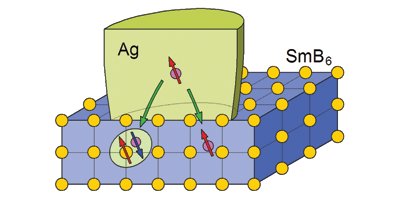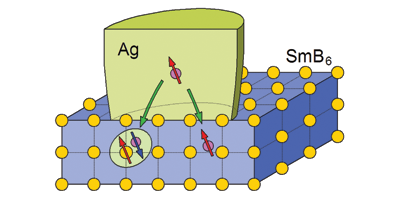Surface Protection
Single localized spins in a material can enlist nearby electrons to form a protective shield. This “Kondo interaction” causes an increase in electron scattering from the isolated spins at low temperature due to a hybridization of localized and conducting electrons. If the localized spins are arrayed in a periodic lattice, this effect can result in the transformation of a metal at room temperature into a Kondo insulator at low temperatures. Recent predictions suggest that one of the canonical Kondo insulators—samarium boride (SmB )—might also show signs of another effect that has reached celebrity status in condensed matter: topologically protected surface states. In a paper in Physical Review X, Xiaohang Zhang of the University of Maryland, College Park, and colleagues report experiments showing that (SmB ) indeed shows conducting behavior at surfaces, much like that expected from topological insulators.
Protected surface-conducting states occur in topological insulators because the electrons’ spin and momentum are locked together, making backscattering only possible with an energetically unfavorable spin flip. Zhang et al. use point-contact spectroscopy to track the evolution of the bulk electron energy states in (SmB ) as a function of temperature. They find that below K, the spectra show the beginnings of the Kondo interaction between samarium ions and the electrons, while around K the formation of the insulating Kondo gap from inter-ion interactions appears. Below K, according to the authors, the bulk material remains in this condition, whereas the observed low-temperature conductivity can only be explained by the formation of metallic surface states.
The experimental discovery of predicted surface states shows the emergence of some intriguing exotic properties of (SmB ). What is needed next is an investigation of the detailed nature of its topologically protected surface conduction. – David Voss





